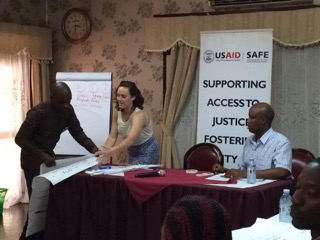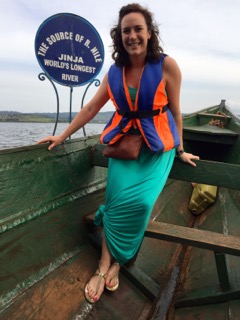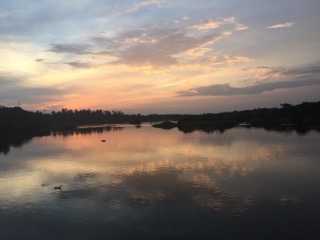Week Three in Jinja: Activities at the Nile
After two full weeks in Kampala and getting to know a bit more about SAFE, Emily and I had the opportunity to attend and participate in the Busoga sub-region Conflict Monitor Training held in Jinja, Uganda. Conflict Monitor Training and the ensuing reporting undertaken by the trained conflict monitors is crucial to the success of SAFE’s Component II; trained conflict monitors report conflict incidents occurring throughout Uganda back to SAFE. SAFE then records and tracks the incidents, examining the motivations, actors, results, and responses to each incident, as shared and verified by the conflict monitors, leading to the creation of a monthly Conflict Assessment Report and establishing a database tracking ongoing conflicts. Without the work and assistance of the individual conflict monitors living throughout Uganda, it would be much more difficult to discover and track each incident.
Fifty people residing in the Busoga sub-region were selected from 10 different districts: Buyende, Bugiri, Iganga, Jinja, Kaliro, Kamuli, Luuka, Maylige, Namayingo and Namutumba. The trainees were nominated for participation because of their stature in the communities; conflict monitors must display high moral character, be well thought of in their communities, have the ability to avoid bias in reporting, be literate, and speak English. The Jinja deputy Resident District Commissioner (much like a Governor in the United States) opened the training session by reminding the participants that they all had value. Their presence at the training demonstrated the high regard with which the communities members regarded the trainees. They represented various sectors of professional society: teachers, bankers, development officers, students, etc. Despite their diverse backgrounds, each participant shared similar desires of security and certain reduced tensions within their communities.
Emily and I participated in the training with the other 50 attendees, despite having much less to offer with respect to knowledge on conflicts in the various districts. The trainees were quick to welcome us, however, creating an extra district designated as “America.” We also facilitated some of the sessions during the training. I coordinated the conflict assessment group work, which required trainees in neighboring districts to identify the five most pressing conflicts in their area, the potential solutions, and specific person or organization best equipped to resolve the conflict. Many of the groups failed to provide the required specificity during the first presentation but took time outside of the training to come together after dinner and revise their information.

Through the training, I met so many interesting people, many that had been focused on community development for some time or others that were just beginning. The passion for their communities and drive to create a change that many people have was inspiring.
Jinja, as the location of the source of the Nile River, offers numerous outdoor activities to visitors and residents alike. On our first night in Jinja, the SAFE team members brought Emily and I to the actual source of the Nile River. Apparently, over 30% of the Nile’s water volume comes from an underground spring located at the Lake Victoria border. Although upon arriving at the “Source of the Nile,” it seems like any other riverbank, it was quite unbelievable to think that I was actually looking at the Nile River, something that, as a child, I spent so much time learning about abnd drawing its course. We did take a boat ride to the actual source and saw the roiling bubbles indicating the spring far below us under the water.

Because Jinja is a beautiful town and Emily and I weren’t able to do nearly all we wanted to do in the few days of the training, we stayed behind to explore over the weekend. After having a “relaxing” day by the pool, we spent the following day exploring Jinja town, investigating the craft markets (great variety of crafts at very reasonable prices!), coffee shops, and trying to locate a highly recommended Indian restaurant with unlimited naan and dal. We were successful in all aspects, ending our day at Moti Mahal restaurant, where the rave reviews failed to fully capture the amount of food we recevied. After attempting to walk off our large afternoon meal, Emily and I returned to our hotel as we were soon to be picked up for a sunset cruise along the Nile, courtesy of Nile River Explorers.
The sunset cruise was incredible, as could be expected from a two-hour cruise along the Nile. I was fortunate enough to sit next to an avid bird watcher from New Zealand who taught Emily and I quite a bit about the birds of the Nile. While the landscape surrounding the Nile was obviously a high point, seeing the local people washing and playing along the banks of the Nile was a joy. There was quite a bit of waving between the boat and banks each time we passed a group of people.

On Sunday, Nile River Explorers again provided transportation and the coordination of our activity for the day - whitewater rafting on the Nile. Despite growing up in an area with plenty of opportunities for rafting, I had never been but had talked about the possibility of going since arriving in Uganda. After receiving some basic safety information and our breakfast of rolex (chapati wrapped around an omelette - a common food in Uganda), we headed for our put in along the Nile. Once we arrived, we were split into groups depending upon our level of “crazy.” Emily and I were split into different boats as I chose to be with the “craziest” group of all. In our raft of six people, four had significant rafting experience.
On the water, we received a much more intensive safety lesson as well as information for what to do if and when our raft flipped (either swim or wait for the safety kayaker to pick you up). I admit, I thought very little about the potential for flipping before heading out on the water or what a flip would entail while on the rapid. If I had, I most likely would not have followed through with our rafting plan!
There were 8 rapids that we would cross in a four-hour period. The first four rapids, we crossed with no problem. Our guide, knowing that I had not been before, asked how I liked it so far. After excitedly responding, “I can’t believe I’ve never done this! It’s not scary at all!” someone reminded me we had yet to flip. There were some complaints as to the lack of flipping. However, at the next rapid, accurately entitled Vengeance, our raft went over immediately upon entry. I consider myself to be a strong swimmer and very comfortable in any body of water but this was like nothing I’d experienced before. You can see the churning water all around you as you’re being tossed around, frantically trying to get a breath. I was caught underneath the side of the boat, desperately trying to reach the rope to pull myself into the pocket of air underneath the overturned raft. Each time I thought the rapid had come to an end and I could finally breath, Vengeance took us for another ride. Truthfully, I can’t even remember where I ended up once it was over, whether I remained with the boat or had to swim back towards it. All in all, it probably lasted 20 seconds but felt like 20 minutes. I learned later, in looking at the pictures and talking to our guides, that the first flip was intentional. The control the guides have over the raft is unbelievable. I was lucky enough to have two incredible guides in my raft, one of whom had been to the Olympics in 2012 as the African representative for freestyle kayaking.
Our raft flipped twice more after the initial flip. The second time we flipped, I again was frantically trying to find air without taking in a gallon of Nile water, when I looked to my right and saw both of my raft guides swimming AGAINST the rapid to get back to our raft, flip it, and then pick the swimmers up. I can’t even contemplate the comfort level they have in the water to not only be able to breathe and think coherently after a flip but to have the strength to swim against the currents. I could not even pull myself back into the raft after a flip, instead kneeling wherever the guide deposited me while I waited for my strength to return. I truly cannot say enough about our guides. Beyond just their comforting presence in the back of the raft, they were so much fun. Four hours passed much too quickly. For anyone considering a trip to Uganda, Nile River Explorers is a must-do. The staff are professional and enjoyable and they make planning any trip unbelievably simple, whether it’s rafting, horseback riding, four-wheeling, or just setting up accommodations.
To say the least, rafting proved to be the perfect end to a weekend in Jinja. Should I find myself with any free weekends before I leave, I will certainly be returning to Jinja and Nile River Explorers for either a kayaking lesson or another rafting trip down the Nile.